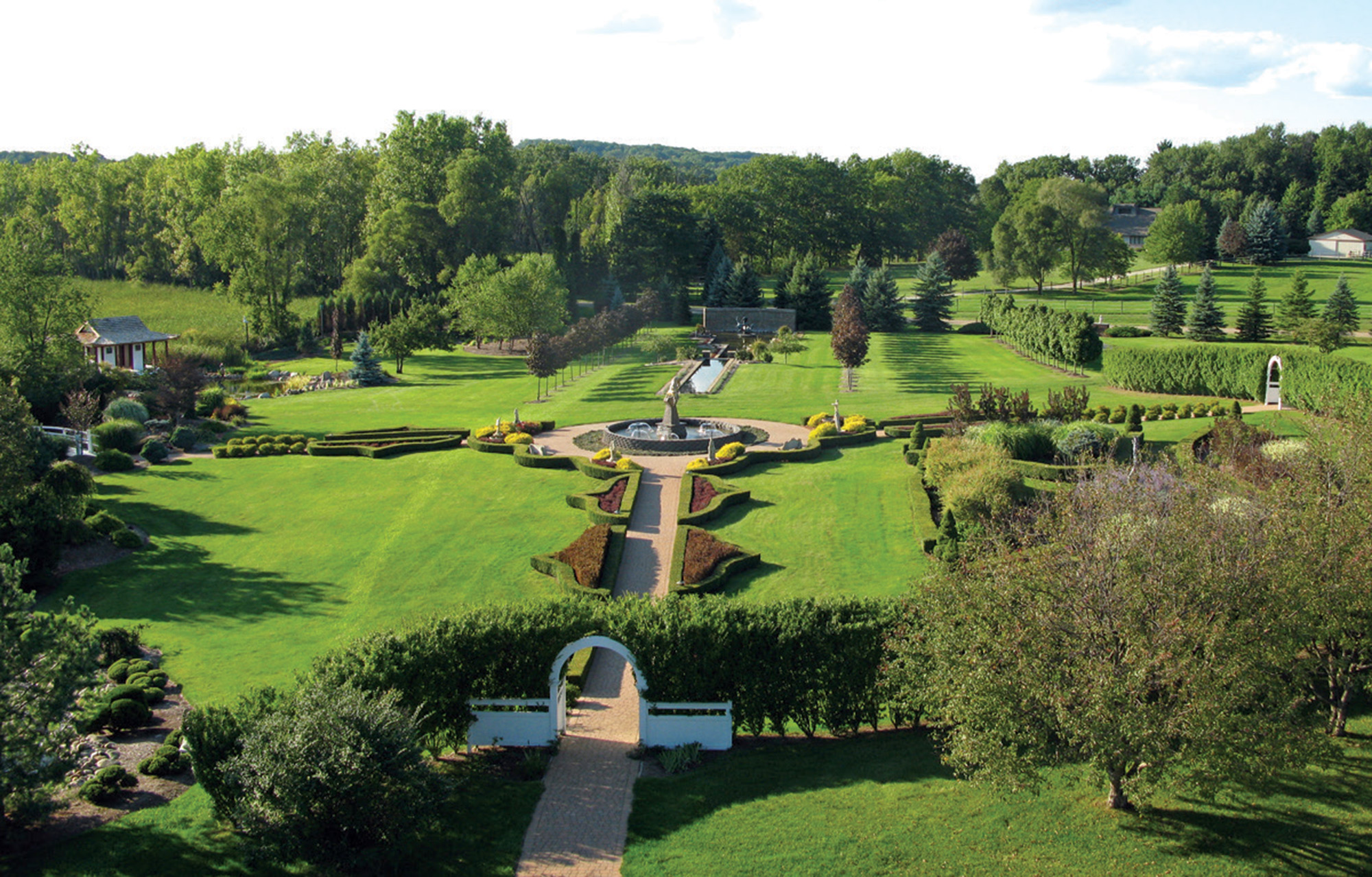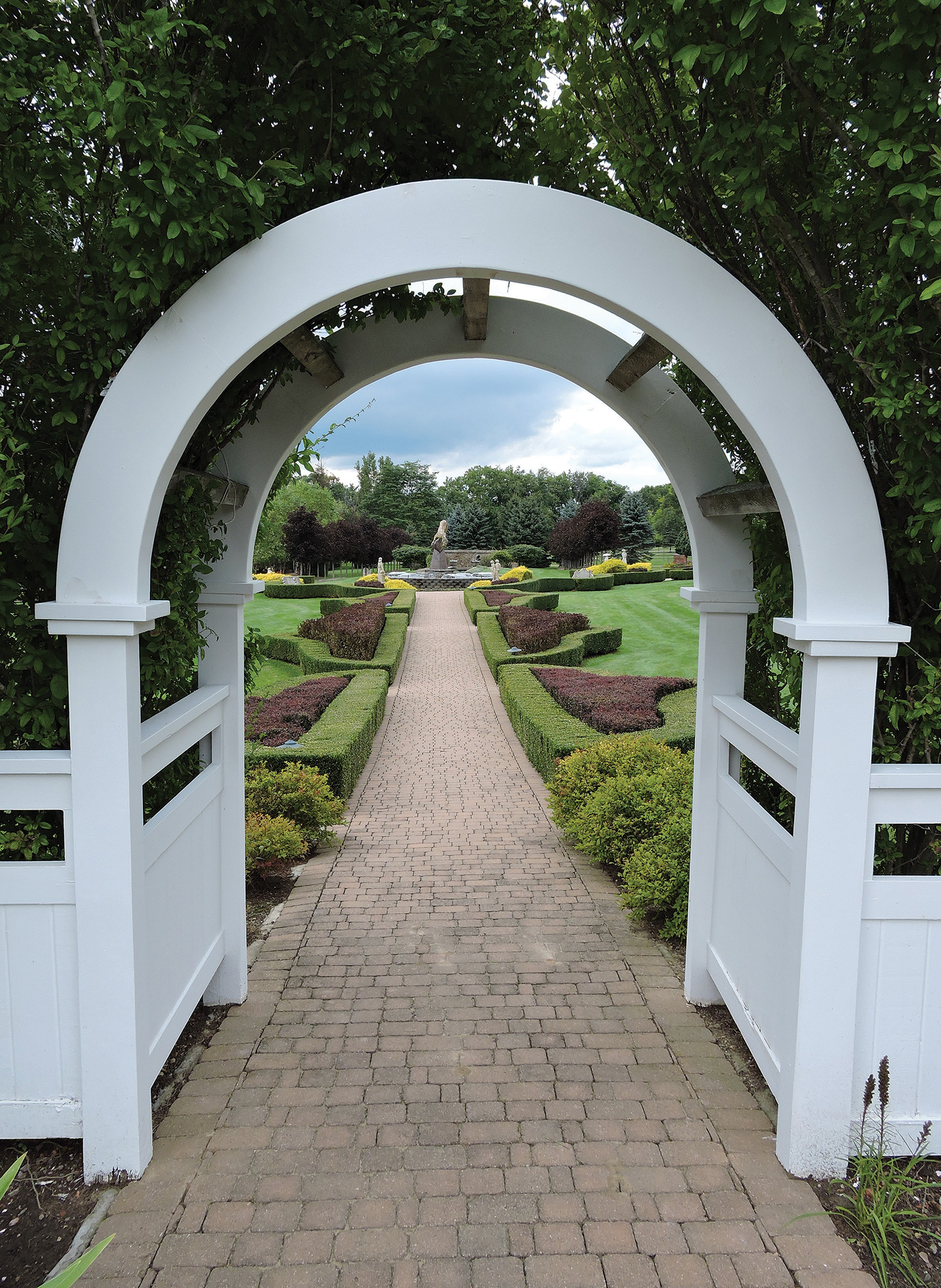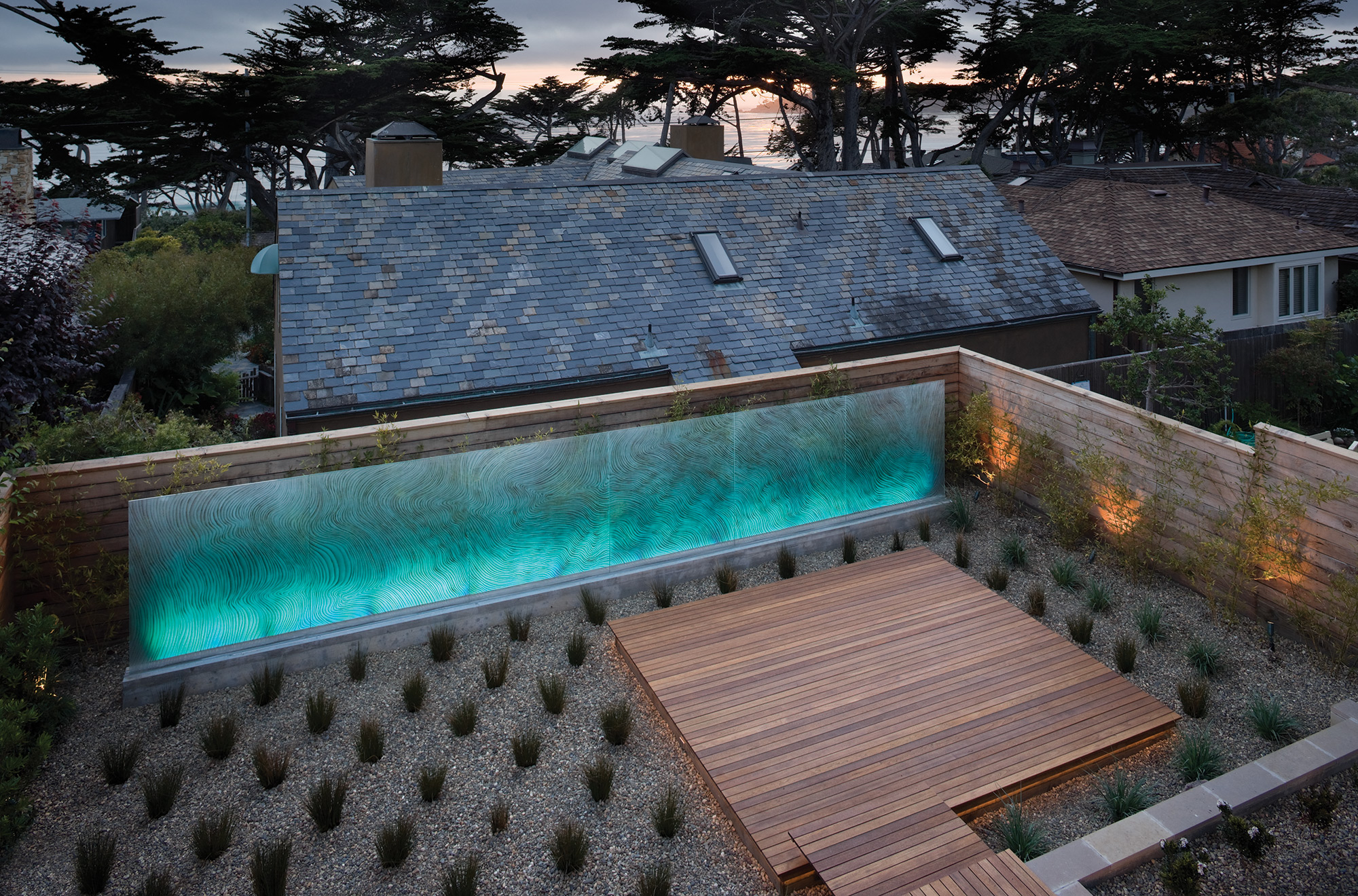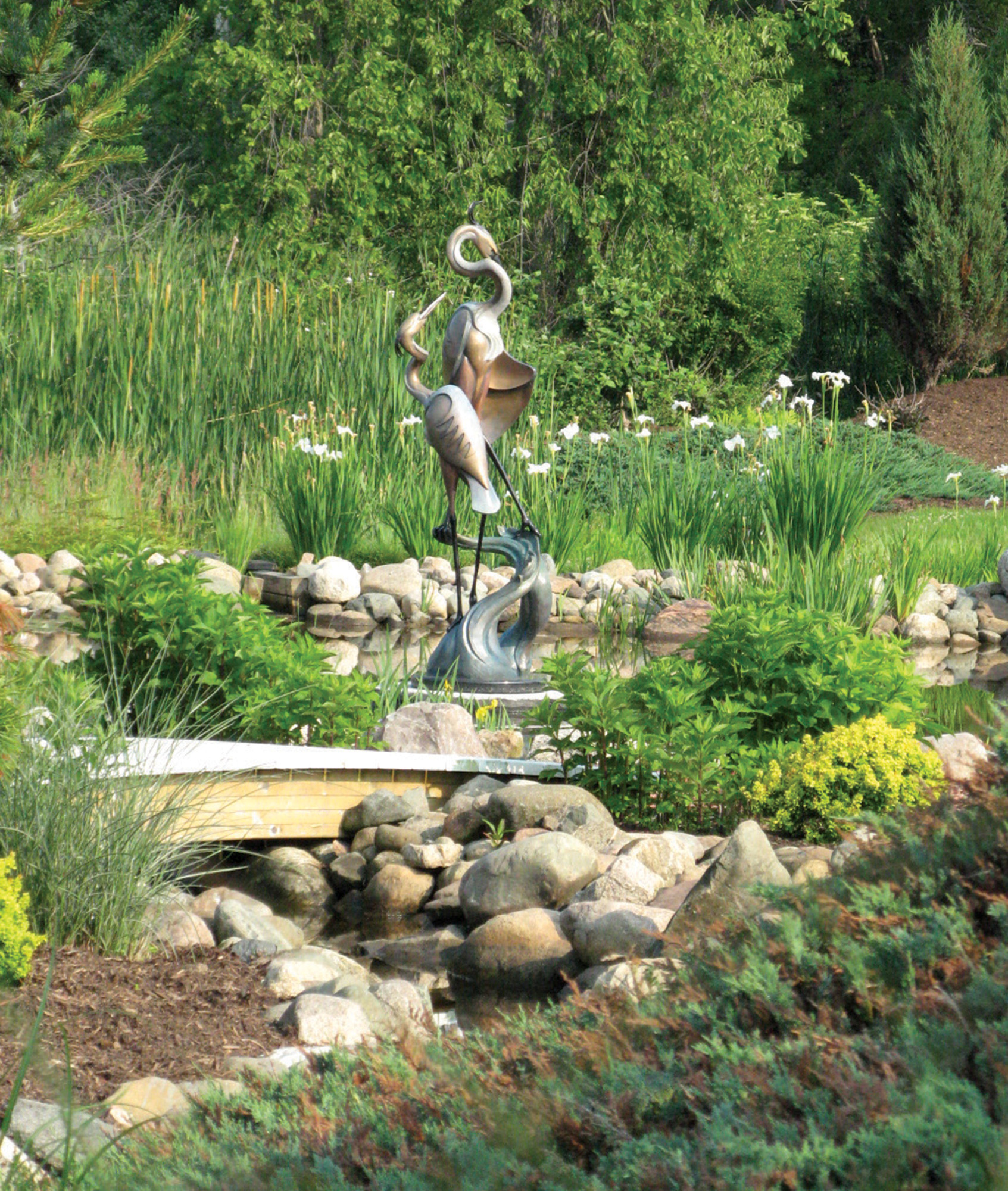
04 Aug Collector's Notebook: Creating an Artful Sculpture Garden
When Tom Christal designed his dream vacation home in Carmel, California, he chose to reference the Pacific Ocean only 300 feet away. Working with renowned artist Gordon Huether, who specializes in large modern sculptures, Christal commissioned a 30-foot-long, 6-foot-high glass wall with curvaceous lines that resemble waves. The sea-inspired sculpture would serve as the focal point in his small backyard, where he and his wife, Lyn, preferred to entertain. The couple wanted something everyone could enjoy each time they hosted an event. Today, the magnificent piece is backlit by a series of changing LED lights that gently fade in and out.
“This is an untraditional sculpture garden,” says Christal. “I wanted one statement piece. The intention is to remind you that the ocean is right outside.” The sound of crashing waves is heard from the backyard, amplifying the glasswork as though it were a living organism.
His sculpture garden breaks several misconceptions and teaches two things: First, you don’t need a yard the size of a state park to start a sculpture garden. Christal’s is only 40 feet wide and 100 feet long. Second, you don’t need to install numerous pieces. A handful or even one is enough to make a bold impression.
The key to Christal’s success was to have great partnerships with the professionals designing the garden and art. “You are creating an entire place,” he says. “The place has to shake hands with the house, and everything has to work together.”
Christal started with a blank slate and hired a landscape architect to design the plans. He also involved structural engineers to calculate how deep to dig the trench for the glass, and his relationship with the artist, who oversaw the installation, was especially crucial.
The couple discovered Huether’s work at the Salt Lake City airport, where the sculptor holds the prestigious honor as principal artist and art curator. His monolithic sculptures are found throughout each terminal. After being wowed by his capabilities, Christal met Huether in his Napa Valley studio, and they collaborated from there.
Indeed, having the artist participate in the process is important when you want a sculpture to look just right. Knowing how the sun hits the work throughout the day and how the water mist from sprinklers might affect the material is insight that can only come from the artist. However, you should work with an artist who shares your vision and is flexible, notes Bernhard Zünkeler, curator at ESMoA art lab in El Segundo, California. “If they do not agree on your strategic approach, they can kill the project altogether before it even flies,” he says.
Having a vision for your space makes the difference between a sculpture garden that is ho-hum and one that is dynamite, Zünkeler says, noting that sculpture can elevate a collector’s surroundings to a higher level. “There is no rule except for it to be beautiful. Be provocative. Be impolite. And don’t stick to a focus that makes you a prisoner of your own concept.”
Wildlife sculptor Jason Napier of Friday Harbor, Washington, often works with clients to install commissioned pieces. He flies to their homes to inspect the grounds and offers advice on where certain pieces should land on the property. Most of the time, customers are anxious to get his input on placement and orientation. His philosophy? “I try to feed them with information and let them make their own decisions.”
Richard Tapper, founder of Tapper Gardens, has been a patron of Napier’s for several years. Tapper has transformed his property with eight of the artist’s bronze sculptures, including peacocks, swans and a bench made from two pheasants. In their partnership, Tapper explains the type of sculpture he would like, and Napier is free to run with the general idea to produce a custom work of art. Once the piece is finished, he delivers it to the location and helps with the final stages of placement. He also discusses ideas for vegetation and flowers to enhance the artwork. “I want the customer to be totally tickled about it. I call every couple of months to make sure,” Napier says.
Any yard, big or small, can benefit from sculpture. A blast of culture can make a space much more intriguing, and a professional landscaper or designer can give an educated opinion. Landscape designer Davis Dalbok, owner of Living Green Design in San Francisco, California, often finds himself handling clients’ design dilemmas. One customer asked him to help position his new 800-pound sculpture made of steel. Once Dalbok saw his yard, he realized the modern piece needed more height among the plants. He also suggested building an elevated turntable so the owner could rotate the sculpture and view it from different angles throughout the day. Problem solved.
The right consultants can prevent a crisis from the outset. In humid Hawaii or arid Arizona, your artwork may deteriorate if neglected. “Weather is an important thing to consider,” says Alexander Salazar, an art advisor and curator from San Diego, California. “Climate is crucial to the survival of any work of art for the outdoors. The best is a bronze sculpture. The bronze will patina, so make sure you are prepared for the change, but patina makes the art alive, and it can be a beautiful thing.”
A homeowner from Atlanta, Georgia, collects wildlife bronzes. To keep the patina in tip-top shape, he has them waxed by a professional conservation company every two years. He started with one piece about 25 years ago, a bronze deer by Dan Ostermiller. Now, he has five wildlife sculptures stationed among the trees and grass throughout his acre-and-a-half yard, and each one is visible from the comfort of his sunroom. One of his favorites is a bronze bear that weighs about 1,000 pounds. It is large, yet blends in with its surroundings.
According to Salazar, collectors should not be afraid to go big when selecting pieces for the garden. “The sky is the limit,” he says. “Enjoy the freedom of monumental artwork.”
Once you know exactly where to place your sculptures, be sure to correctly install them. When Christal’s glass wall arrived in five panels, contractors dug a deep trench and poured enough concrete to perfectly anchor the sections. Since California is earthquake country, he wanted to ensure that Huether’s creation would be able to withstand any changes and slight shifts. Stabilizing your works of art is essential. Leveling the ground can be necessary because even the slightest elevation will make your piece look crooked. “You want to make sure your piece never topples over and gets ruined,” says Salazar. For that reason, hire a landscape architect or structural engineer who can assess the ground before anything else.
An artful space can be a powerful experience for the viewer, so be purposeful. “A sculpture garden creates an oasis that combines natural elements with art that touches our hearts,” Shanan Campbell Wells, owner of Sorrel Sky Gallery in Durango, Colorado, says. “Whether meditative, inspirational, sentimental or whimsical, these collections take on a tangible value; a value that endures and grows with time.”
- After passing through the archway at Tapper Gardens, visitors encounter an enchanted world of bronze animals and waterfowl. The private garden is open to the public only two or three days a year, though the Tapper family uses the property to host weddings and other special occasions.
- This sculpture, by artist Gordon Huether, echoes the Pacific Ocean less than half a mile away. The owner can change the wall’s LED lights according to his liking, allowing the sculpture to glow different colors at night. written by Kathy Chin Leong
- “Poetic Gestures” stands at attention amid lilies in one of the three ponds at Tapper Gardens.
- Surrounded by pitch perfect greenery composed of more than 4,000 plants and trees, “Moonlight Howls” is a howling landscape success at Tapper Gardens. In the distance, sculptures “Precious Cargo” and “Poetic Gestures,” also by Jason Napier, create ambiance within the landscape.










No Comments